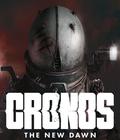The Recharged series of games has emphasized taking well-known classics and giving them a modern look, with gameplay that retains the spirit of the original score chasers. Asteroids, Centipede and Missile Command are some titles that received this treatment, and there's little doubt that many more well-known Atari games will also go down this route. What's surprising and welcome is the fact that some of the company's lesser-known hits are also in this series, a trend that began with Black Widow. The latest one to also make the journey is Gravitar Recharged.
Like previous releases, Gravitar Recharged isn't burdened with a narrative. Instead, the main mode, Arcade mode, behaves exactly the same way that the original did. Your ship is thrust upon a solar system, and you move on from planet to planet. The objectives can range from simply destroying all enemies to blowing up the core to stealing intelligence documents and activating beacons. Complete the objective, leave the planet, enter another planet, and repeat the process of clearing out solar systems before you lose all of your lives.
The gameplay loop may seem rudimentary now, but what makes both the classic and Recharged versions of the title so interesting are the mechanics. Gravity and momentum play a huge part in movement because you can't change directions instantly like you'd expect in many shooters. Your shots are always in three-bullet bursts instead of delivering a constant stream. Fuel is also a thing to consider, and while you aren't going to die if your reserves are drained, you will float aimlessly until you can't avoid colliding with an object and end up dying.
Governing this is a control scheme that is better than both the button-only scheme of the original arcade and the one used in the Atari Flashback Classics package released a few years ago. The left analog stick controls spin, the A button fires the gun, zR controls boost, and zL activates a 360-degree tractor beam to pull stuff in. It feels natural due to the boost no longer being tied to the Up direction, so you feel like you can get further compared to the original iteration.
The control scheme may be easier, but it doesn't mean that you'll instantly get used to the controls and physics. Expect to lose control of your ship often and find yourself pinballing against walls and knocking you out of a planet. Most of your early runs will be spent doing this or going at a snail's pace, with light taps on the boost as you pray that the enemy gunfire and mines completely miss you while you're trying to line up your shots. This is a game where you need a good deal of practice before you can make any real progress.
That said, Gravitar Recharged makes some concessions that were also present in the original iteration that make the overall experience less daunting. You have a shield that gets replenished after five seconds, so unless you run into laser walls or get in the blast radius of mines, you won't experience one-hit deaths too often. Like the original, dying doesn't affect progress because you can return to a planet to finish off your objective instead of restarting. There are also a few power-ups like invincibility or homing missiles, but unlike other Recharged games, their scarcity makes them feel more important since you'll rarely get to use them.
All of this comes together for an experience that feels more modern ,even though it carries almost everything from the classic title. Part of this comes from the randomization of levels and goals that you get with every run. Combined with the randomization of the planets and the fact that you restart after losing all of your lives, what you have is essentially a roguelike minus the ability to grow stronger from every run. With an audience that is starting to gravitate toward difficult experiences in their games, this approach works well with them in mind.
The other mode, Missions, is more rigid, as it takes away the space portion of the game and the presence of lives to focus on completing specific tasks. The levels are also static, so you can't die and retry in hopes of getting a better level layout. It acts more like a challenge mode in this respect, and it might be better for those looking for more structure, since you'll be tasked with unlocking more challenges by completing previous ones. The mode also works for those seeking short gameplay bursts, since the need for exploration and resource management has evaporated.
About the only thing that doesn't translate so well is the co-op variants of Arcade and Mission modes. As the name suggests, you get to take on the same objectives in either mode, this time with a partner in tow to help. There are no concessions made for the presence of an extra player, so don't expect things like bonus objectives or unique items. While co-op is generally a proven formula in making most experiences better, it doesn't really do that here due to the game's trickier control scheme. Unless you and your gaming partner are patient, expect plenty of frustration to come up until both parties come to grips with the game mechanics.
The presentation is where the game shines. It's similar to past Recharged games in that it sports pastel colors for a number of important objects, like red for enemies and teal for you and your power-ups. It is also different in that the colors stand out much more thanks to an extensive use of black for the game's rocky outcroppings, asteroids, and structures. Combined with the distinct yet muted backgrounds that are reminiscent of minimalist, old Atari box covers, and you have a game that looks stunning in stills or in motion, no matter whether you're going docked or portable. Accompanying the visuals is a soundtrack that matches the sci-fi vibe but is also haunting by not being too audacious or dreary. Of all of the releases in the series thus far, this is perhaps their best soundtrack yet.
Gravitar Recharged shows the Recharged series in a good light. The mechanics take some time to master, but doing so feels rewarding while the game's score-based nature feels right for modern audiences, thanks to the randomization of planet layouts and objectives. It's artistically stunning and accompanied by a soundtrack that matches up with the visuals. Co-op is hit-and-miss, but based on everything else, it's a good pick for those who want an arcade game with mechanics that aren't emulated too often.
Score: 7.5/10
More articles about Gravitar: Recharged











 The cult classic Gravitar has been Recharged. Complete missions in each solar system, navigating a variety of challenging environments, each with varying levels of gravity that test your skills as a pilot before unlocking new solar systems to explore.
The cult classic Gravitar has been Recharged. Complete missions in each solar system, navigating a variety of challenging environments, each with varying levels of gravity that test your skills as a pilot before unlocking new solar systems to explore.







